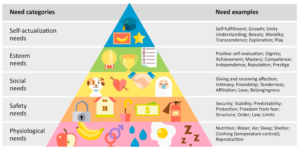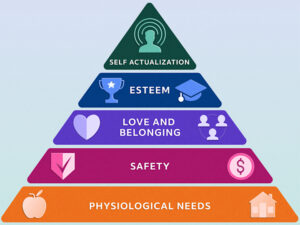What is Maslow’s Hierarchy of Needs?
Do you also love a workplace where everyone performs their tasks voluntarily and does not need close supervision? Motivation is the most critical lever for optimal performance in the hands of managers and leaders of any organization. With Maslow’s Hierarchy of Needs, you can motivate employees by meeting their needs to achieve maximum participation in your workplace.
Maslow’s theory of the Hierarchy of needs is a model for describing the psychology of human motivation. With the help of this theory, you will spend less time guessing the needs of employees and more time doing motivating tasks for employees.
History of the Hierarchy of Needs or Maslow’s Pyramid
In 1943, a humanistic psychologist named Abraham Maslow proposed the theory of the Hierarchy of needs in his article titled “Theory of Human Motivation.” According to Maslow, we all humans have needs that we must satisfy, from the most basic to the most complex of these needs.
According to Maslow, people satisfy their basic needs before moving on to more advanced needs.
Imagine you have not eaten for three days to understand this principle better. Your dissatisfaction with this situation gives you a strong incentive to find food. At that moment, you are unlikely to have any motivation to do your homework.

According to Maslow, “A person who lacks food, security, love, and respect is likely to be hungry for food more than anything else.”
In short, the unfulfilled physiological need often monopolizes a person’s thoughts and diminishes any idea of satisfying higher-level needs, such as esteem and knowledge.
Once the basic needs at a certain level are satisfied, the next level in the Hierarchy emerges more strongly and becomes a motivator for behavior and thought. According to Maslow’s theory, a satisfied need is no longer an active motivator. Therefore, once a person has satisfied a need, they will seek to meet a higher need.
An example of Maslow’s pyramid in the workplace
Many are motivated by the hope of increasing their salary. Once people have satisfied their monetary needs, they are encouraged to get a higher salary or a different goal.
5 levels of Maslow’s pyramid, from basic to ultimate needs
Maslow considers the five basic human needs as follows:
1.Physiological needs
2.Safety needs
3.Social needs
4.Esteem needs
5.Self-actualization needs
Maslow’s model presents a hierarchy of needs in a pyramid. Here is a version of Maslow’s Hierarchy:

Basic Needs (Levels 1-2)
Level 1 of Maslow’s Hierarchy: Physiological Needs
Basic physiological needs (also known as physiological drives) ensure our survival. Some examples of physiological needs include:
Food
Water
Shelter
Warmth
Sleep and rest
Homeostasis (the body’s natural mechanism for maintaining a stable and constant environment)
These physiological needs are the most basic in Maslow’s Hierarchy and give people hope for survival. Once they are met, we move on to more advanced needs.

Motivating Employees with Physiological Needs
Provide employees with enough food and water or ensure they know what to bring to work. The more clarity you can provide, the better.
Ensure adequate heating and cooling of the workplace to maintain the temperature and comfort of employees.
If your business requires outdoor work, provide employees with appropriate clothing for all weather conditions.
Stock a variety of healthy foods in the company’s cafeteria, kitchen, and vending machines.
Keep workspaces well-maintained, especially where workers spend a lot of time, such as desks and production lines. Ensure the quality of the air in the workplace and take steps to improve these spaces.
Maslow’s Second Level: Safety Needs
Once a person’s physiological needs are met, safety needs come into play at the second level of Maslow’s Hierarchy. Safety must focus on ensuring we do not put ourselves in danger and the innate desire for control and predictability. Safety needs include:
Protection from the elements and risks (such as shelter and clothing)
Peace of mind and freedom from fear
Job security or earning a living
Legal protection
Financial security (having a steady income to cover living expenses)
Security from accidents, illness, and injuries at work and home
The most common needs experienced by people at this level include feeling safe at home or work, maintaining family security, and financial security (having enough money to meet basic needs such as food and water). Once these needs are met, people will move on to more complex needs.

Motivate employees by meeting safety needs.
Provide a safe and secure work environment with clear guidelines and responsibilities and ensure adequate workplace security.
Ensure employees know they can be with their families without fear of judgment or adverse consequences. This includes family-friendly policies such as leave for emergencies, birthdays, flexible work hours, and more.
Managers should use strategies such as implementing new policies on safety and well-being, harassment, bullying, and equal pay.
Consider offering health insurance as part of employee benefits.
Ensure that all employees receive safety and health training and have the right to voice their opinions and criticisms.
Employees should not be overworked and paid a fair wage to support themselves and their families.
Paying employees on time should be a priority when managing their finances.
Psychological Needs (Levels 3-4)
Level 3 of Maslow’s Hierarchy: Social Needs

Once we have met our safety needs, we quickly move on to social needs, including closeness to others, interpersonal relationships, and belonging. We often refer to this level as love and belonging. Specific social needs include:
The need for friendship: The nature of social psychology drives us to seek out close friends and people we can rely on.
The need to feel loved and accepted
A sense of belonging: This is one of our most important psychological needs, which we can fulfill by joining groups and clubs or being friends with people with similar interests.
A sense of love or affection: Refers to the feeling of being loved or cared for by others.
The need for family affiliation: The feeling of belonging to a family is critical and is closely related to the sense of love.
The need to be loved: Most people recognize this one. Often, a person wants to be liked and viewed positively.
Isolation, anxiety, and depression are all undesirable states, and this is where social needs are so important. When these needs are denied, it is easy for a person’s psychological well-being to suffer.

Motivate employees by meeting social needs.
Plan and organize activities that involve employees in the workplace or outside the office, such as exercising or having lunch with colleagues after work or having coffee and a walk and talking during lunch.
Hold team-building exercises inside or outside the workplace to connect employees during social activities such as outings and games.
Involve your employees’ families in work events and try to build a community around your business.
Have a company newsletter to share information and help create a sense of community. Newsletters are an easy way to disseminate motivational details in multiple areas and give direction to employees.
As leaders, we rarely talk about love in business and think that’s a mistake! According to Maslow:
“We have to understand love. We have to be able to learn it, create it, and predict it. Otherwise, the world will be lost in hostility and suspicion.”
Steve Farber writes a great book on leadership and love. In his book, “Love is Just Damn Good Business,” he tells us that if we can make love an integral part of the business culture, employees and customers will understand their actual value.
He seems to agree with Maslow. By addressing the need for love, you can develop employees who are more loyal, innovative, creative, and inspiring and who deliver a great customer experience.
Level 4 of Maslow’s Hierarchy: Esteem Needs
Once we have met social needs, we move on to esteem needs. Esteem needs refer to a person’s sense of worth and are usually related to the person’s ability to meet expectations or standards.
Esteem needs include:
A sense of competence or mastery over the environment (for example, in a work project or an athletic achievement)
Self-esteem needs: A person’s sense of worth is usually the result of the person’s ability to meet expectations or standards in some way.

Recognition at work, at home, or in society at large
The desire to be important to others, such as being seen as an expert.
The need for autonomy and independence, meaning the desire to act without being told how to behave.
Motivate employees by meeting esteem needs
Provide challenging work with opportunities for advancement that align with employees’ skills and abilities.
Give employees responsibility for projects or tasks that build on their experience, skill base, and confidence.
Don’t put employees in positions that are beyond their capabilities. The manager’s job is to build people up and support them as they move at the right pace.
These strategies are great ways to help address insecurities by providing an environment where people can feel competent while still performing to your and their expectations.
Self-Actualization Needs (Level 5)
Level Five of Maslow’s Hierarchy: Self-Actualization Needs
Once the four levels of Maslow’s Hierarchy have been met and the needs for esteem and respect have been met, we can ascend to the top of Maslow’s motivational pyramid, where the need for self-actualization exists.

The desire for self-actualization is in human nature to realize our inner potential. Abraham Maslow defined it as: “…the desire to become more and more of what we are and all that we are capable of becoming.”
Self-actualization is the desire to achieve personal growth needs and reach our full potential. Self-actualization needs include:
The need for appreciation and recognition refers to the desire for others to notice your achievements.
The need for creativity refers to improving skills and thinking up new ideas or solutions.
The need for personal growth, which is the motivation to learn more about yourself, for example, by trying something you have never tried before or learning a new skill, can improve your self-esteem.
Self-actualization also includes being aware of one’s shortcomings in order to work on them and improve. Managers can help employees with personal development to increase their self-awareness and acceptance of their weaknesses.
Therefore, self-awareness is present in all learning and development programs, especially leadership development, management training, and emotional intelligence courses. Only when individuals know their strengths and weaknesses can they work on personal development.
Only a few people usually succeed in satisfying self-actualization needs. This is because some skills (often soft skills) are hard to acquire. Typically, it is difficult to achieve self-actualization if all other needs are not satisfied, at least to some extent.

Motivating employees with self-actualization needs
Provide opportunities for professional growth.
Provide access to self-help books, articles, and videos on employee interest topics.
Grant time off so employees can attend classes or workshops that your job requires.
Try to understand an individual’s higher-level goals and provide feedback on their progress toward self-actualization (give guidance when necessary, but try to coach rather than dictate).
Provide guidance and assistance with difficult decisions so that the individual can express their thoughts without fear of being judged before making a final decision about their work.
Maslow believes that: “… the individual’s intellectual integrity must be maintained… he should not feel that his boss has taken control of him.”
A Lesser-Known Level in Maslow’s Hierarchy
Level 6: Self-Transcendence at the Top of Maslow’s Hierarchy
Although Maslow’s Hierarchy often depicts five levels, there is a lesser-known sixth level that Maslow considered the true pinnacle of motivation. He called this higher-order need “self-transcendence.”
The concept of self-transcendence represents the drive to move beyond oneself and individual concerns. At this level, one connects with something greater, such as spirituality, a greater good, or a higher purpose.
Self-transcendence involves a sense of unity, oneness, and interconnectedness with existence, as well as a search for meaning and values that transcend personal interests.
In the context of Maslow’s Hierarchy, self-transcendence is a higher-order need that emerges after lower-order needs have been satisfied.
This concept represents another stage of personal growth and self-discovery, where a person seeks to understand their place in the world. In doing so, they develop a deeper connection with others, nature, and the world.
Key point: It is important to note that Maslow’s Hierarchy of needs lacks a strict or linear progression. Individuals may experience different needs simultaneously or move back and forth between levels.
However, self-actualization suggests that human growth can extend beyond self-actualization to a broader and more connected life experience. You can see the six levels of Maslow’s Hierarchy in the infographic below:
Applying Maslow’s Hierarchy in the Workplace
If you are a manager or leader, Maslow’s theory can help you understand your employees’ needs and provide a framework for guiding them toward positive, voluntary behaviors (doing positive things because they want to, not because you asked them to!).Maslow’s Hierarchy reflects an individual’s innate desire for “self-actualization,” the time when they can maximize their talents and abilities.
Your goal as a manager or leader should be meeting your people’s needs.
Key point: Maslow explained that satisfying all needs at a given level is unnecessary before other, higher-level needs emerge. It is nearly impossible to meet all of them at once.
According to Maslow, many of a person’s human needs are met to some extent simultaneously. Lower-level needs are also usually met more frequently. Therefore, leaders and managers must meet the most immediate needs at each level to help employees meet their esteem and self-actualization needs.

People are also motivated to achieve or maintain conditions that support the five basic needs.
For example, a person would go to great lengths to ensure they have water because their physiological needs would not be met without it. In this particular example, the result of cutting off water would have serious consequences and would undoubtedly hinder the climb to self-actualization.
An important point for managers trying to create specific behaviors is that a behavior requires more than one motivation. Therefore, focusing on one need as a lever is not your best strategy.
Essential points for leaders and managers
Here are some important points for leaders and managers looking to apply Maslow’s Hierarchy in the workplace:
1. Recognize individual needs
When using Maslow’s Hierarchy, it is important to consider each team member’s needs, goals, and aspirations.

Organizing regular one-on-one meetings, performance reviews, or informal meetings can help leaders better understand these needs. Knowing their team can help leaders better tailor their approach to meeting these needs.
2. Prioritizing Basic Needs in Maslow’s Hierarchy
Leaders and managers should prioritize meeting the basic needs of each team member in the workplace. Ensure your employees have a comfortable work environment, adequate health and safety measures, and competitive salaries and benefits.
3. Fostering a Positive and Inclusive Culture
A positive work environment that values open communication, collaboration, well-being, and diversity can increase team motivation and productivity.
Providing ample opportunities for collaborative work (such as teamwork), social interaction (team building or social events), and the ability to resolve conflicts quickly and fairly helps create a positive culture. This, in turn, will help your team meet its social needs and create a more motivated and happier team.

4. Recognize employees and provide feedback
To meet self-actualization needs, it is essential to regularly acknowledge your team’s achievements and provide constructive feedback and praise for a job well done.
Depending on the needs of the individual or team, rewards for good work can be provided, such as bonuses, event tickets, coupons, etc.
5. Support growth and development
Leaders and managers can provide regular opportunities for growth, development, and skill enhancement to support team members’ self-esteem and self-actualization needs.
This can be done through training programs, networking events, coaching opportunities, etc.
6. Empowerment and delegation
Giving employees autonomy and control over their work can greatly increase their motivation and self-esteem. Delegating some of your important tasks to them can also make your employees feel empowered and motivated.
7. Communicate clearly
Communication is always key when leading teams.

Being transparent about goals, outcomes, and organizational changes can help your team feel involved, appreciated, and valued in the company. Employees who feel more trusted and secure in your team will be more motivated to complete their work tasks.
8. Promote work-life balance
Encouraging work-life balance is essential to increasing motivation. Benefits such as flexible working hours, regular breaks, and vacation pay are also minimal in modern, large companies.
Employee health also helps prevent burnout, stress, and job turnover.
Growth needs vs. deficiency needs
Maslow believed that deficiency needs (the first four levels), which provide the foundation for his Hierarchy, play a significant role in human motivational behavior.

Physiological, safety, social, and esteem needs all stem from deficiency. Thus, satisfying these lower-level needs is essential if we want to avoid unpleasant feelings or consequences.
In contrast, the higher needs on Maslow’s pyramid are also called growth needs. These stem from the desire to grow, not due to a lack or deficiency.
Key point: If we cannot satisfy deficiency needs at least partially, the likelihood of self-actualization is very low. This is why managers should work on the Hierarchy of needs and ensure that only a few unmet needs are met.
Finally
Maslow’s pyramid is an excellent tool for managing employees based on their innate needs. Leaders and managers can use the Hierarchy of needs in strategic and operational planning to create a positive work environment and increase employee motivation.